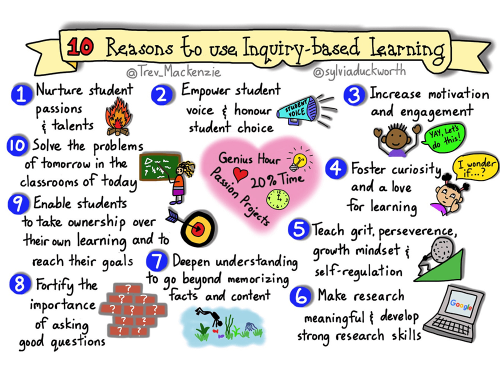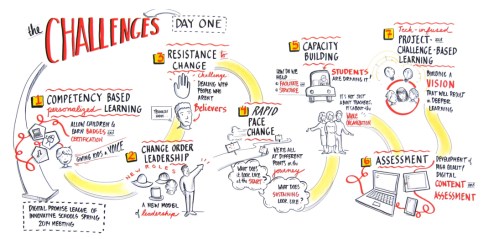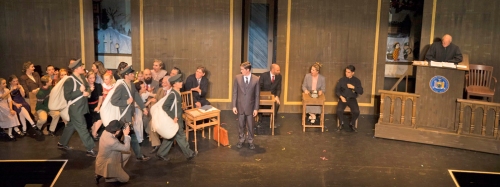Starting out at a new school, I decided it was time to re-examine my personal philosophy of teaching and education.
Over the last several years, as I have been reporting my experiences in these blogs, I have paid attention to how effective I am as a teacher and what sorts of activities and lessons seem to resonate with students and provide memorable learning opportunities for them. From this I have developed my own model of education, which I have shared at conferences and workshop sessions. I will be starting a Doctorate of Education (EdD) program this fall at the University of Northern Colorado, specializing in Innovation and Education Reform. This will be a means for backing my theories up with empirical research, not just the anecdotal evidence I have now. I already know what I want to do for my doctoral thesis.
This is my revised model so far, with examples from my teaching experiences:

This is my revised model of education, what could also be called the Levels of Engagement model. The purpose of education, in my experience, is to move students from ignorance (no knowledge of a subject) through passive learning (sitting and watching or listening) to active learning (hands-on, experiential) and beyond to creative learning (students as explorers, teachers, and innovators). Students move from being consumers of educational content to interacting with content to creating new educational content or new science, engineering, art, math, or technology. The students become makers, designers, programmers, engineers, scientists, artists, and problem solvers.
I call this the Creative Classroom model, as the goal is to move students from Ignorance (lack of knowledge or experience with a subject) through the stages of being a Passive Learner (sitting and listening to the teacher or a video and consuming content) through being an Active Learner (students interacting with content through cookbook style labs) to becoming a Creative Learner (students creating new content as innovators: teachers, makers, programmers, designers, engineers, and scientists). Let’s look at these levels in more detail. It could also be titled the Levels of Engagement model, as moving to the right in my model signifies deeper student engagement with their learning.
Level 0: Ignorance
Ignorance is the state of not having basic knowledge of a subject. This isn’t a bad thing, as we all start out in this state, as long as we recognize our ignorance and do something about it. What our society needs are more creative and innovative people, not people who are passive or even willfully ignorant.
Ignorance is not bliss. What a person doesn’t know may indeed hurt him or her – if, for example, you don’t know that mixing bleach with ammonia will produce chlorine gas, you could wind up with severe respiratory problems. A basic literacy for science and engineering concepts is necessary for any informed citizen, since we live in a technological age with problems that need solving and can only be solved through science and technology.
If you do not understand science and technology, you can be controlled by those who do. How many people actually understand the technology behind the cell phones they use every day? They leave themselves vulnerable to control by the telecom companies that do understand and control this technology. If you don’t understand the importance of Internet privacy and share personal information on a website or Facebook page, you leave yourself vulnerable to people or corporations that can track your web searches or even stalk you online (or worse). I am fairly ignorant of the basic techniques for repairing my car. This leaves me vulnerable to paying the high prices (and the possible poor service) of a local mechanic, when I could save lots of money and ensure quality if I only knew how to do it myself.
As teachers our first responsibility is to lead students away from a state of ignorance. This seems simple enough, but anyone who teachers teenagers (and even some so-called adults) will know that some of them insist on remaining willfully ignorant, usually because they mistakenly think that they already know everything they need to know, which is never true of anyone. As the Tao Te Ching says: “To know what you know, and what you do not know, is the foundation of true wisdom.” So the first step to becoming a creative learner is to delineate, define, and accept our areas of ignorance.

A quote from the introduction of “Most Likely to Succeed” by Toni Wagner and Ted Dintersmith. How long will it take before education systems realize that the old factory model of education is no longer working?
Level 1: Passive Learning
When people start learning a subject they are usually not sufficiently self-motivated to learn it on their own – but we hope they will reach that point eventually. Most inexperienced learners are passive. They wait for their teachers to lead the lesson, sitting in their seats listening to lectures or watching a movie or otherwise absorbing and consuming educational content. The focus in such classes is to complete individual assignments that usually involve only lower order thinking skills such as recall and identification. This is the level described in the quote above from Most Likely to Succeed by Toni Wagner and Ted Dintersmith.
At this level, teachers emphasize mastering the facts and basic concepts of a subject. Students are consumers of educational content, but do not interact with it or create new content. Common classroom activities include listening to lectures and taking notes or answering basic questions, watching a video or demonstration, completing worksheets, or reading a text. Student motivation is usually external, based on the desires of parents or teachers and the fear of negative consequences (poor grades, etc.).
Education at this level is all about efficiency but isn’t very effective, since less than 10% of what teachers share in lectures is retained by students beyond the next test. Evaluation is based on standards, not skills. There is always a need for students to learn facts and concepts, but it is better to provide engaging projects where the students will find out the facts on their own as a natural part of completing the project.
Level 2: Active Learning
At this phase, students start developing internal motivation as they engage and interact with content. Students are beginning to explore, but usually through activities that are fairly structured although more student centered than before. These activities are hands-on; students are doing and acting, not sitting and listening.
Common classroom activities would be “cook-book” style labs, with step-by-step instructions and pre-determined outcomes. Students begin to learn observation and inquiry skills, with some data collection in a controlled environment along with data analysis. Teachers still determine if the student has the “right” answer. They start to practice the 21st Century skills of collaboration, communication, and critical thinking. Unfortunately, most science classes stop at this level without moving beyond hands-on to the deepest level.

Inquiry-based learning shares many of the features of project or problem-based learning, in that it is student centered and empowers student voice and choice, allows a high level of engagement and meaningfulness as students take responsibility and ownership for their learning, and teaches resilience, grit, and perseverance.
Level 3: Creative and Innovative Learning
If the purpose of STEAM education is to teach students how to become scientists, technology experts, engineers, artists, and mathematicians then they must learn the final stages of inquiry: to ask and answer questions, to solve problems, or to design products. The purpose of science is to answer questions whereas engineering has the goal of solving problems through designing and testing prototypes. Both are creative endeavors as the result of learning is something new for society – new knowledge or new products.
In the Creative Classroom, the environment is completely open, without predigested data or predetermined conclusions. Students work on projects where they research a question important to them, develop a methodology, decide how to control variables, make observations, determine methods of analysis, and draw and communicate conclusions. At this level, students become innovators or inventors. They synthesize knowledge and apply it to themselves and teach others through writing blog posts, creating posters or infographics, presenting lessons and demonstrations, and filming and editing videos or other educational media. They become makers and programmers, building products of their own design. The students are creating and contributing to society by making new content, knowledge, and solutions.
Learning at this level is never forgotten but is difficult to evaluate with a multiple-choice test, as the focus is on skill mastery and competency instead of easily regurgitated facts. Overall, this deepest (and most fulfilling, motivational, and engaging) level is entirely student centered and driven, with instructors as mentors. Ultimately, once a student has practiced learning at this level, the teacher is no longer necessary; the students will continue to learn on their own, because they are now entirely internally motivated. These are the people that society will always need.
How This Impacts My Teaching:
As an educator, my goal is to move students toward Level 3 activities and projects. Where I succeed, the projects my students work on are meaningful to them, demand professional excellence, use authentic data, involve real-world applications, are open-ended, and are student-driven. The students are required to create, make, program, build, test, question, teach, and design. They are innovators and engineers; they are creative students.
To give some examples from previous blog posts on my two sites:

Representative color image of the Rachmaninoff Basin area of Mercury, created by my students using narrow band image data from the MESSENGER space probe at 430, 630, and 1000 nm. We stretched the color saturation and image contrast so that we could see differences between volcanic (yellow-orange) and impact (blue-violet) features.
My chemistry and STEAM students created an inquiry lab to study the variables involved in dyeing cloth, including the history, ancient processes, types of cloth, mordants (binders), types of dyes, and other factors. We also explored tie dyeing, ice dyeing, and batik and developed a collection of dyed swatches that we will turn into a school quilt. We also experimented with dyeing yarn with cochineal, indigo, rabbit brush, sandalwood, logwood, etc. and my wife crocheted a sweater from it.
2. My chemistry and STEAM students did a similar inquiry lab to test the variables involved in making iron-gall ink using modern equivalents. We studied the history and artistry of this type of ink (used by Sir Isaac Newton, Leonardo DaVinci, and many more) and tried to determine the ideal formula for making the blackest possible ink. We also created our own watercolor and ink pigments such as Prussian blue, etc. We used the inks/watercolors to make drawings and paintings of the history of chemistry.
3. My astronomy students used accurate data to build a 3D model of the nearby stars out to 13 light years. This lesson was featured in an article in The Science Teacher magazine, including a video of me describing the process.
4. My astronomy students created a video for the MIT BLOSSOMS project showing a lesson plan on how to measure the distance to nearby stars using trigonometric parallax. It is on the BLOSSOMS website and has been translated into Malay, Chinese, and other languages.
5. My earth science students learned how to use Mars MOLA 3D altitude data to create and print out 3D terrains of Mars.
6. My chemistry students created a 12-minute documentary (chocumentary?) on the history and process of making chocolate.
7. My 6th grade Creative Computing class built and animated a 3D model of the SOFIA aircraft prior to my flying on her as an Airborne Astronomy Ambassador.

A 3D render of the Kasei Valles area of Mars, created by students as part of the Mars Exploration Student Data Team project. They learned how to download Mars MOLA data from the NASA PDS website and convert it into 3D models and animations, then created an interactive program on Mars Exploration which they presented at a student symposium at Arizona State University.
8. My science research class collected soil samples from the mining town of Eureka, Utah to see if a Superfund project had truly cleaned up the lead contamination in the soil.
9. My chemistry and media design students toured Novatek in south Provo, Utah and learned about the history and current process for making synthetic diamond drill bits. Another group videotaped a tour of a bronze casting foundry, while others took tours of a glass blowing workshop, a beryllium refinery, and a cement plant.
10. My astronomy students used infrared data from the WISE and Spitzer missions to determine if certain K-giant stars may be consuming their own planets. This was done as part of the NITARP program. They developed a poster of their findings and presented it at the American Astronomical Society conference in 2015 in Seattle.
11. My biology students build working models of the circulatory system, the lungs, the arm, and create stop motion animations of mitosis and meiosis. As I write this, they are learning the engineering design cycle by acting as biomechanical engineers to design and build artificial hands that must have fingers that move independently, an opposable thumb, can pick up small objects, make hand gestures, and grasp and pick up cups with varying amounts of water in them.
12. My computer science students, in order to learn the logic of game design, had to invent their own board games and build a prototype game board and pieces, write up the rules, and have the other teams play the game and make suggestions, then they made revisions. This was an application of the engineering design cycle.
13. My STEAM students designed and built a model of a future Mars colony using repurposed materials (junk), including space port, communications systems, agriculture and air recycling, power production, manufacturing, transportation, and living quarters. They presented this and other Mars related projects at the NASA Lunar and Planetary Science Conference in Houston.
These are just a small sampling of all the projects my students have done over the years. I have reported at greater length in this blog about these and other projects. My intent has always been to move students away from passive learning to active learning to inquiry/innovation. They often create models, build prototypes, collect data, or design a product and it is always open ended and student centered; even if I choose the topic of the project, they have a great deal of freedom to determine their approach and direction. There is never one right answer or a set “cookbook” series of steps, nor a focus on memorizing facts. They learn the facts they need as a natural consequence of learning about their project topics; by completing the project, they automatically demonstrate the required knowledge.

My students designed, animated, and programmed this interface for their Mars Exploration project, then presented it at a student symposium at Arizona State University as part of the Mars Exploration Student Data Team program. They build 3D models and animations of Mars probes, such as the one of the MER rovers shown. In this interface, the Mars globe spins, and as the main buttons are rolled over, side menus slide out and space probes rotate in the window.
Some groups require considerable training and experience to get to this level of self-motivation and innovation, and some team building, communication, and creativity training may be required. Other groups move along more rapidly and have the motivation to jump right in. This means that managing such projects as a teacher can be challenging because every team is different. I find myself moving from being a teacher at the center of the classroom (a sage on a stage) where all students move along in a lock-step fashion to becoming a mentor or facilitator of learning (a guide on the side) as students move toward higher levels of engagement at their own pace and in their own way.
As classroom activities become more student-centered, I find it natural to tie in the Next Generation Science Standards. If I do an inquiry lab to test the variables that affect dyeing cloth, the answer is not known before nor the methodology. Students have to work out the scientific method or steps needed by asking the right questions and determining how to find the answers, or to design, build, and test a prototype product. Through this method they learn the science and engineering processes that are one dimension of the 3D standards.
Crosscutting concepts can also be explored more effectively through this method. Inquiry leads to observations, which should show patterns, processes, models, scale, proportion, and other such concepts, which are the second dimension of 3D science education.
This leaves the third dimension, which is to teach subject Core Concepts. This is where most of the misguided opposition to Project Based Learning comes from. Teachers feel that projects somehow take time away from “covering” all the standards. But if we want deep learning of the core concepts of a subject, we can’t expect students to learn them by using surface level teaching techniques that emphasize facts without going any deeper. If I do it right, I can involve many standards at once in the same project and not only meet but exceed the standards in all cases. I call this “standards overreach” and I will talk about this in more detail in my next post.

Projects don’t have to be a elaborate and complex as the Mars project shown above. Here, my New HAven students have created models of viruses and mini-posters of chemical elements. The green plastic bottle to the left is a model of a human lung.



























